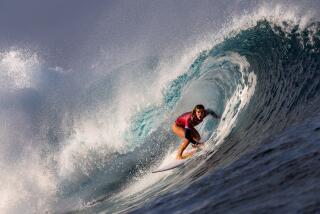SURF COUNTY USA : REPORTER’S NOTEBOOK : It Wasn’t Heavy, It Was Just My First Surfboard
Little Joel Buonassissi, age 10, stood at the water’s edge at Bolsa Chica State Beach. He was garbed in a neoprene-and-nylon wet suit with bright, neon colors, the style that has become de rigueur for today’s young surf generation.
“Hey, wanna see my new surfboard? It’s cool. It like weighs 2 pounds,” he chirped.
He then proudly pushed his board toward me. It was new, there was no doubt about that. The body of the board had neither a ding nor a scratch. As I turned the board, the sun’s rays glinted off the three short bottom fins. It stood just 5 feet, 2 inches. And the whole thing couldn’t have weighed more than 5 1/2 pounds. Six pounds, tops.
Joel is a grommet, one of those kids on the beach who live to surf, who idolize the pros--including many of the world’s top surfers who arrive on Huntington Beach’s shore this week for the Op Pro Surfing Championship, the largest surfing event on the U.S. mainland.
With his new surfboard and hot-looking wet suit, Joel was truly a state-of-the-art Southern California youngster. So I asked him if this was his first new surfboard. He giggled.
“Naw,” he said, “It’s my eighth.”
With the average cost of junior-size surfboards at $200 to $300, Joel’s garage must be heavily guarded. His parents in Seal Beach must have found a tunnel to Ft. Knox.
Quite a contrast to my first surfboard. I was an 18-year-old ex-swimmer from Wilson High School in East Los Angeles, and my board was large, a 9-foot, 6-inch fiberglass Velzy model. It was used. Half was owned by a friend of mine who had a car, so it stayed in his garage.
It cost $90 and was one of the few prized possessions I had. It was so wide and heavy that carrying it was a two-person job. You could do it yourself, but you had to hoist it over your shoulders and balance it on your head. It weighed a ton.
My friend had this little MG sports car, and we would stick the behemoth behind the front seats and head south to the beach. Of course, getting out of City Terrace in East Los Angeles with a surfboard on top of your car in the late 1960s was always interesting. But if I was stopped by the local hoods, I would say I stole the board from some blond-haired surfers. They seemed to like that and never gave me any problems.
In those days, my friend and I used to head for Orange County and Tin Can Beach, the area now known as Bolsa Chica State Beach. Then, you could park free on both sides of Pacific Coast Highway. When you got bored with surfing, you could watch a speedboat pull water-skiers on the highway’s inland side, where an ecological preserve is now located.
Surfing was simpler then. All you needed was a board, some wax and, if you were lucky, a wet suit. The wet suits, which were made of rubber, were unlined and chafed your armpits raw.
The big debate at the time wasn’t whether you were going to smash your board “off the lip” of a wave, or pull a floater, but whether you paddled “prone” or on your knees.
When we had time, we drove down to Main Street by the Huntington Beach Pier and checked out the surf shops, such as The Greek or Chuck Dent’s store.
If you surfed Huntington, sooner or later you had to have a Greek or one of Chuck Dent’s boards.
Most of the boards then had single skegs, which serve as a rudder. They were huge, lethal-looking things that stuck out from the bottom of the board about 10 to 12 inches.
Today, skegs are called fins. And Joel’s peers wouldn’t be caught dead with a single- fin board. It’s got to have three.
Oh, there are purists who still prefer single-fin boards. But to youngsters such as Joel, they are as ancient as black-and-white TVs--or 1960s vintage surfers.
* RELATED STORIES: B5


